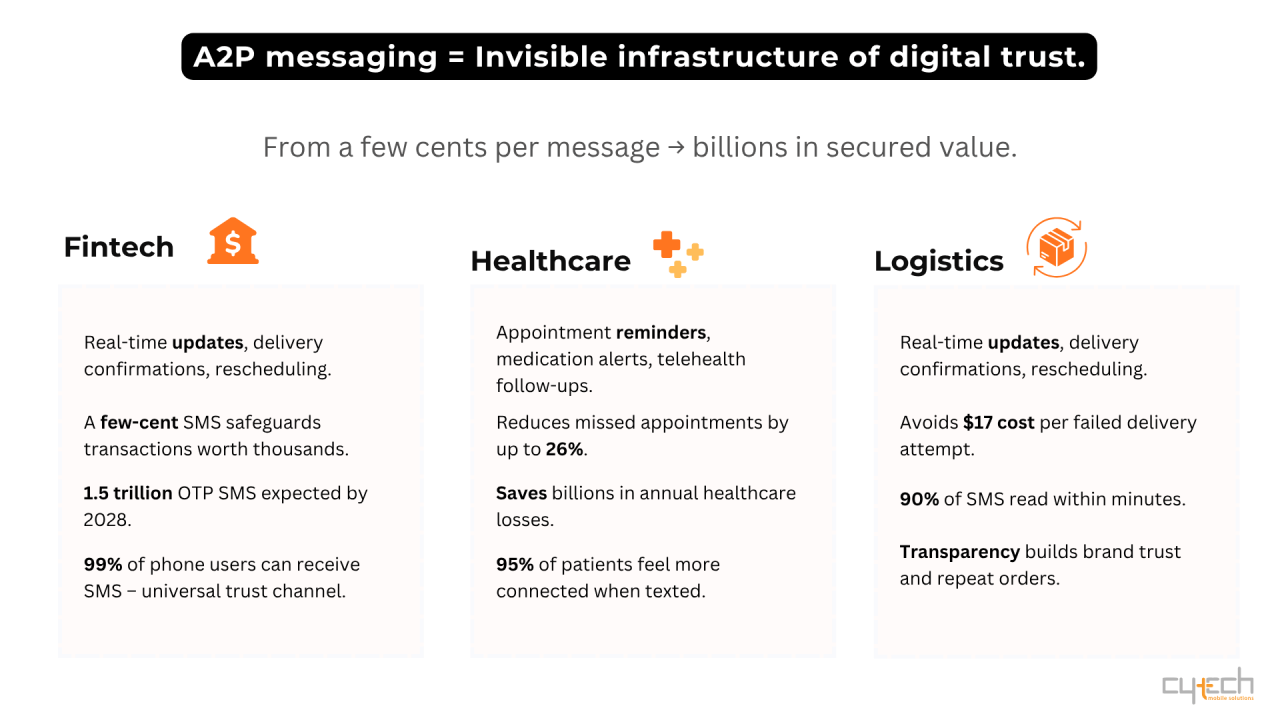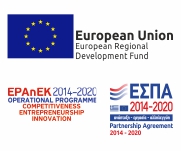Table of Contents
Far from simple texts, A2P messages form an invisible economic and trust layer across industries – a fact reflected in the global A2P market projected to reach $84.8 billion by 2029. Whether it’s a bank verifying a transfer, a clinic confirming an appointment, or a courier updating a delivery, each message carries outsized value in the transaction it enables. Below, we explore how this invisible economy plays out in fintech, healthcare, and logistics, backed by key stats and sources.
Fintech: SMS as the Trust Anchor in Finance
In banking and fintech, A2P messaging has become the security and verification backbone. One-time passwords (OTPs) delivered via SMS are now standard for confirming logins, approving payments, and stopping fraud. Banks worldwide rely on these texts to protect accounts and authorize transactions – a single SMS OTP might unlock a mortgage payment or halt a fraud attempt. It’s no surprise that SMS is the most common form of two-factor authentication, given its ubiquity: virtually 99% of mobile phone users can receive texts. This reach and reliability make SMS an unparalleled trust channel for financial services.
The scale of OTP usage is staggering. Juniper Research forecasts that SMS traffic for OTPs will hit 1.5 trillion by 2028 (up from 1.3 trillion in 2023)– a testament to how many financial interactions depend on a simple text code. Indeed, the banking, financial services, and insurance (BFSI) sector is one of the fastest-growing adopters of A2P messaging, with its A2P SMS market expected to nearly triple from $3.2 billion in 2024 to $8.7 billion by 2034.
Each of these messages underpins high-value exchanges: authorizing a wire transfer, resetting an online banking password, or alerting a cardholder to suspicious activity. In economic terms, a few-cent SMS can safeguard a transaction worth thousands – preventing costly fraud or compliance breaches. Little wonder that despite the rise of app-based authenticators, banks continue to send billions of SMS alerts as a trusted, regulated conduit for customer verification and peace of mind.
Healthcare: Texts That Save Costs and Build Trust
In healthcare, A2P messaging quietly improves both outcomes and the bottom line. Hospitals and clinics use SMS to remind patients of appointments, prompt medication refills, deliver test results, and even conduct telehealth follow-ups. These messages may seem routine, but they directly translate to economic value in healthcare operations. Missed appointments (“no-shows”) are a notorious drain on resources – each vacant slot costs an average of $200 in lost revenue, contributing to an estimated $150 billion annual loss for U.S. medical practices.
By sending timely SMS reminders and confirmations, providers dramatically reduce these no-shows. Studies show that text reminders can cut no-show rates by up to 26% and in some cases boost attendance by 67% when compared to no reminder at all. Every percentage drop in missed appointments means millions saved in healthcare – a clear economic win achieved through a simple text message.
Beyond protecting revenue, SMS enhances patient engagement and trust in care providers. Patients are more likely to show up and comply when they feel informed and supported. After implementing texting programs, 95.5% of patients reported feeling more connected to their care team. This sense of connection is critical – it leads to better adherence to care plans and reinforces loyalty to the provider. Importantly, patients now expect this channel: 98% of consumers who use texting want healthcare providers to be responsive over text just like other industries.
By meeting patients on SMS – a channel with a 98% open rate, usually read within 3 minutes – healthcare organizations not only improve service but also strengthen trust. An appointment reminder text today can prevent a costly no-show tomorrow, and build long-term confidence in the provider’s reliability. In short, A2P messaging in healthcare carries weight far beyond its characters: it can mean a filled timeslot, a healthier patient, and a more efficient, profitable practice.
Logistics: Delivering Efficiency and Customer Confidence
From shipping companies to online retailers, the logistics sector relies on A2P messaging as an integral part of delivery workflows and customer service. Every time you get a “Your package is out for delivery” SMS or a one-time PIN to retrieve a parcel, there’s an economic calculus at play behind the scenes. Efficient, transparent deliveries save money – and SMS is the workhorse enabling that efficiency at scale.
Consider the cost of a failed delivery attempt. If a courier arrives when a customer isn’t home or has an incorrect address, the package often requires re-delivery or pickup coordination. These failures are expensive, costing about $17 on average per missed delivery in additional handling, fuel, and customer service time. Across thousands of deliveries, that quickly erodes margins.
Proactive SMS notifications help avoid these costs by keeping recipients informed and prepared: customers can reschedule or adjust plans upon receiving a text update, ensuring they’re available at the first delivery attempt. In Europe, studies show an 8% first-attempt failure rate for online orders – with businesses paying a combined $193,000 to redeliver just 140,000 orders. Sending addresses confirmations, ETA alerts, or delivery PIN codes via SMS can significantly lower that failure rate, directly translating into savings. In other words, a 10-cent message can prevent a $17 redelivery expense, at scale.
A2P messaging in logistics also serves as a customer trust and retention tool. Delivery delays or surprises are a top source of customer frustration. An SMS is an instant remedy – 90% of texts are read within minutes, so if a truck is running late or a signature is needed, a quick text keeps the customer in the loop. This transparency preserves goodwill. In fact, 84% of consumers say they would likely abandon a brand after just one poor delivery experience, but they’re far more forgiving if issues are communicated and resolved quickly.
Many companies report that simply providing real-time updates via text significantly reduces “Where is my order?” calls to customer support, cutting labor costs and improving satisfaction. Moreover, a sizable segment of customers prefers SMS for delivery communications – nearly one-third choose text updates over email for shipping and delivery confirmations. By meeting customers on their terms with timely SMS alerts, logistics providers not only avoid direct costs, but also strengthen loyalty and repeat business. In sum, each delivery SMS is part of an invisible bargain: a small messaging cost in exchange for a smoother, more trusted delivery experience that protects revenue and brand reputation.

Conclusion
Across fintech, healthcare, and logistics, A2P messaging functions as far more than just a communication channel – It is an economic utility and a backbone of digital trust. These 160-character messages quietly ensure that money moves securely, appointments happen, and goods reach their destination. The “invisible economy” of A2P lies in all the value safeguarded or unlocked by a simple text: a fraud prevented, a sale completed, a service delivered on time.
For businesses and telecom operators, this means A2P messaging deserves strategic attention as a revenue driver and differentiator. And for users, the humble SMS continues to deliver confidence that things are running as they should. In an increasingly automated world, A2P messages have become the tiny but mighty transactions that underpin larger economic activity. They are an unseen layer of trust enabling the connected economy to function smoothly, one text at a time.

